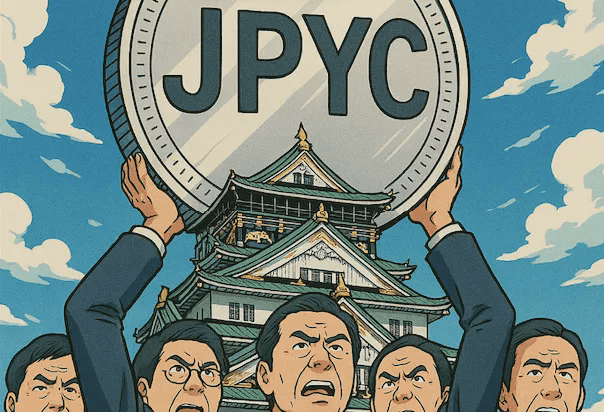In the global wave of digital assets, a sector that has long been dominated by US dollar stablecoins (like USDT and USDC) is undergoing a structural transformation. The Financial Services Agency (FSA) of Japan is expected to officially approve the issuance of the country's first digital currency linked to its legal tender—the yen stablecoin JPYC—by this autumn.
This is not only a key step for Japan in the digital finance field but also a strong signal that a new era of diversified global stablecoins supported by multiple sovereign fiat currencies is accelerating. From Tokyo to Hong Kong to Seoul, major financial centers in Asia are collectively awakening and paving the way for their local fiat currencies' 'digital avatars'.
This wave led directly by regulatory agencies in various countries may have a final goal that is not just to reshape domestic payments but also to target the current global cross-border payment hegemon—the SWIFT system. A more efficient and lower-cost global financial infrastructure is rising; should SWIFT really be worried?
Yen stablecoin

The first to seize the opportunity this time is JPYC Inc., a fintech company from Tokyo. According to the plan, the company will complete the registration process as a 'fund transfer operator' within this month and lead the launch of the first fully compliant Japanese yen stablecoin.
JPYC will strictly maintain a fixed value of '1 yen = 1 JPYC'. The confidence behind it comes from fully transparent and strictly regulated reserve assets. Similar to mainstream US dollar stablecoins, JPYC's reserves will consist of high liquidity quality assets, primarily including bank deposits and Japanese government bonds (JGBs). This means that every JPYC circulating in the market is backed by an equivalent real yen asset.
The approval of JPYC perfectly reflects Japan's cautious path of 'regulating first, developing later' in financial innovation. In May 2023, Japan officially amended the Payment Services Act, which for the first time included stablecoins as payment instruments for management, explicitly restricting issuance subjects to banks, trust companies, and licensed fund transfer operators. This approach is starkly different from the 'develop first, govern later' model adopted by some countries, prioritizing consumer protection and the stability of the financial system, laying a solid legal foundation for healthy market development.
For a long time, even in the Japanese market, the circulating stablecoins were mainly foreign US dollar stablecoins. The advent of JPYC will historically break this situation and provide Japanese companies and individuals with a more trustworthy digital payment and settlement tool based on their national currency, which is significant for consolidating Japan's financial autonomy in the global digital economy.

It is worth noting that the influence of JPYC extends far beyond the payment field. Its issuing company's representative, Noritaka Okabe, keenly pointed out that the rise of the yen stablecoin could even bring profound changes to Japan's enormous national debt market. The logic here is clear: the expansion of stablecoin issuance means a simultaneous increase in the reserve asset pool behind it. Since JPYC uses Japanese government bonds as one of its core reserve assets, the larger its issuance volume, the stronger the demand for Japanese government bonds.
Norihiro Okabe cites the experience of the United States as an example: The largest issuers of US dollar stablecoins globally, such as Tether and Circle, have long been major buyers of US Treasury bonds. To maintain their reserves, they have purchased hundreds of billions to over a trillion US dollars in US Treasury bonds, becoming important support for US government financing.
Okabe bluntly stated: 'JPYC is likely to significantly increase its purchases of Japanese government bonds in the future.' This introduces a new institutional buying force from the digital finance sector into the Japanese government bond market. This force has the potential to help stabilize or even lower the yields on Japanese government bonds, thereby reducing the government's financing costs. Conversely, those countries lagging in the development of stablecoins may face upward pressure on government bond yields due to missing out on the demand from such new institutions. This also explains why many governments, including Japan's, are accelerating the promotion of stablecoin regulations and framework building from the strategic height of national monetary policy.
Asia's collective awakening

Japan's actions are not an isolated case. Looking across Asia, a regulatory race surrounding stablecoins has already begun. Hong Kong has officially implemented its Stablecoin Regulation on August 1, 2025, which is not aimed at prohibiting the circulation of foreign stablecoins like USDT or USDC, but the core regulatory target is stablecoins issued in Hong Kong or pegged to the Hong Kong dollar. This clearly indicates that Hong Kong aims to become a 'compliance hub' for global stablecoins, providing an ideal registration and operational center for stablecoin issuers seeking to operate under a clear legal framework.
At the same time, South Korea is also accelerating the formulation of its stablecoin legislation, which is expected to be launched in October this year. This shows that establishing a regulatory framework for local fiat stablecoins has become a consensus among major economies in East Asia.
As stablecoins like the yen, Hong Kong dollar, Chinese yuan, and potentially the South Korean won flourish within their respective compliance frameworks, they weave together a new blueprint for a global payment network. The potential competitor to this blueprint is the SWIFT system, which has dominated global cross-border payments for half a century.
According to industry research organizations, the settlement volume of stablecoin networks has reached an astonishing scale. In July 2025 alone, the total on-chain stablecoin settlement reached 3.3 trillion US dollars. Models predict that by 2026, the annual settlement scale of stablecoins will reach 5 trillion US dollars, which could pose a substantial challenge to SWIFT's business in specific areas.
The advantages of stablecoins over SWIFT are evident: first, lower costs, bypassing the complex system of traditional agents with layered fees; second, faster speeds, achieving near real-time peer-to-peer settlements; third, 24/7 operation: continuous without interruptions, with no holiday or working hours restrictions.
In the past, these advantages were mainly reflected in US dollar stablecoins. In the future, with the rise of non-US dollar stablecoins, more direct trading corridors of 'non-US dollar' will open up. For example, Japanese importers may be able to directly pay Hong Kong exporters using JPYC in the future, without needing to first convert yen to dollars and remit through the SWIFT network, where the counterpart would then convert dollars to Hong Kong dollars, as in traditional models.
Era of diversified stablecoins
Japan's approval of the first yen stablecoin JPYC is certainly not an isolated financial event. It is a critical juncture in the evolution of the global financial system from a single center to a diversified pattern. A world of compliant, diversified stablecoins supported by multiple major economic currencies is transitioning from blueprint to reality.
SWIFT's position may not be overturned overnight, but its long-established 'moat' based on network effects and path dependence is being eroded by blockchain technology. A faster, cheaper, and more inclusive parallel financial infrastructure is taking shape. This silent revolution led by stablecoins has deep far-reaching implications, and we may just be beginning to see the tip of the iceberg.

